When it comes to choosing between stun guns and firearms for self-defense, think about what fits your lifestyle best. Stun guns are lightweight and easy to use, delivering a high-voltage shock to temporarily disable an attacker. They’re great for close encounters and usually have fewer legal restrictions. On the other hand, firearms offer serious stopping power but need more training and regular practice. Plus, they come with strict laws and responsibilities. Ultimately, it’s all about your comfort level and the situation you might face. Curious about more aspects of these self-defense options? Stick around for deeper insights!
Key Takeaways
- Usage Scenario: Stun guns are ideal for close encounters, while firearms provide distance and lethal force in more dangerous situations.
- Legal Considerations: Stun guns generally have fewer restrictions than firearms, but legality varies by location; verify local laws before purchasing.
- Training Requirements: Stun guns require minimal training, making them user-friendly, whereas firearms necessitate comprehensive training for safe handling and operation.
- Effectiveness: Stun guns incapacitate temporarily with less risk of permanent harm, while firearms can quickly neutralize threats but carry higher risks.
- Personal Comfort: Choose a self-defense weapon that aligns with your comfort level and situational awareness; non-lethal options may feel safer for some users.
Understanding Stun Guns
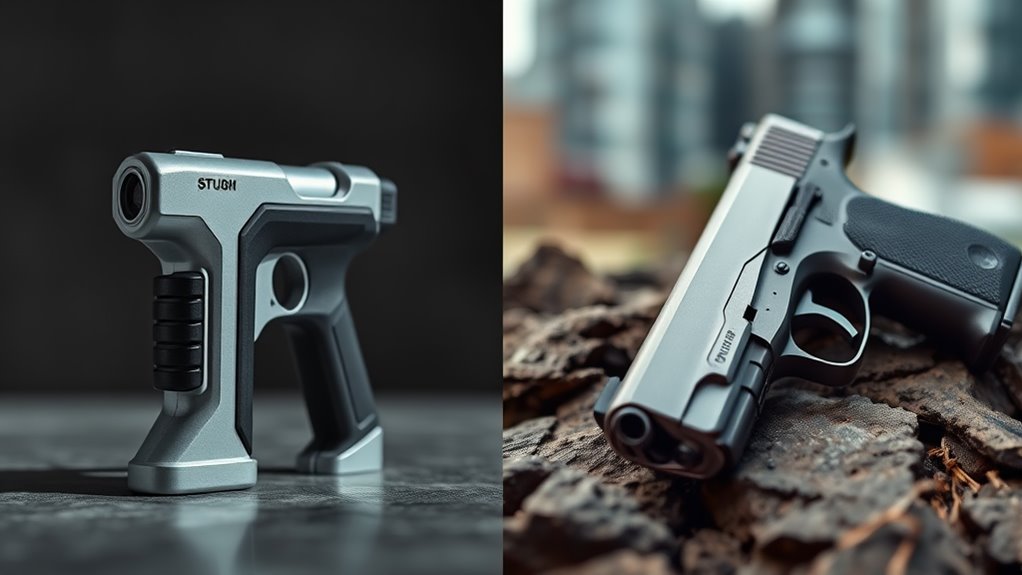
Stun guns are popular self-defense tools that deliver a high-voltage shock to incapacitate an attacker temporarily. When you choose a stun gun, you’ll notice various stun gun features, like size, voltage, and built-in flashlights. These features can make it easier to carry and use in an emergency. But don’t forget about stun gun safety! Always check local laws to verify you can carry one legally, and practice using it in a safe environment. Remember, it’s not just about having a stun gun; it’s about knowing how to use it effectively. Stay calm, and aim for the attacker’s torso, as this is where you’ll get the best results. With the right knowledge, you can feel more confident and prepared. Additionally, some stun guns come with a rubberized handle for improved grip, which can be crucial during stressful situations. Furthermore, certain stun guns, like the Safety Technology Shorty, offer dual functionality with a flashlight, enhancing their utility in self-defense scenarios.
Understanding Firearms
When it comes to self-defense, firearms offer a different level of protection compared to stun guns. You’ll find various firearm types, including handguns, rifles, and shotguns, each with unique features and uses. Handguns are often easier to handle, while rifles provide accuracy and power. Understanding your options is essential. The Rechargeable Tactical BashLite provides an alternative with its high voltage stun capability and durable construction, offering a non-lethal option for self-defense.
But owning a firearm means you need to keep up with firearm maintenance. Regular cleaning and inspections guarantee it functions properly when you need it most.
Remember, a well-maintained firearm can be your best ally in a dangerous situation. So, whether you’re considering a pistol or a shotgun, do your research, practice safe handling, and stay informed about how to care for your weapon.
It’s all about being prepared! Additionally, for those exploring non-lethal options, the 110,000,000 volt stun baton offers a versatile choice with its 3-in-1 design as a stun weapon, flashlight, and heavy-duty club.
Legal Considerations
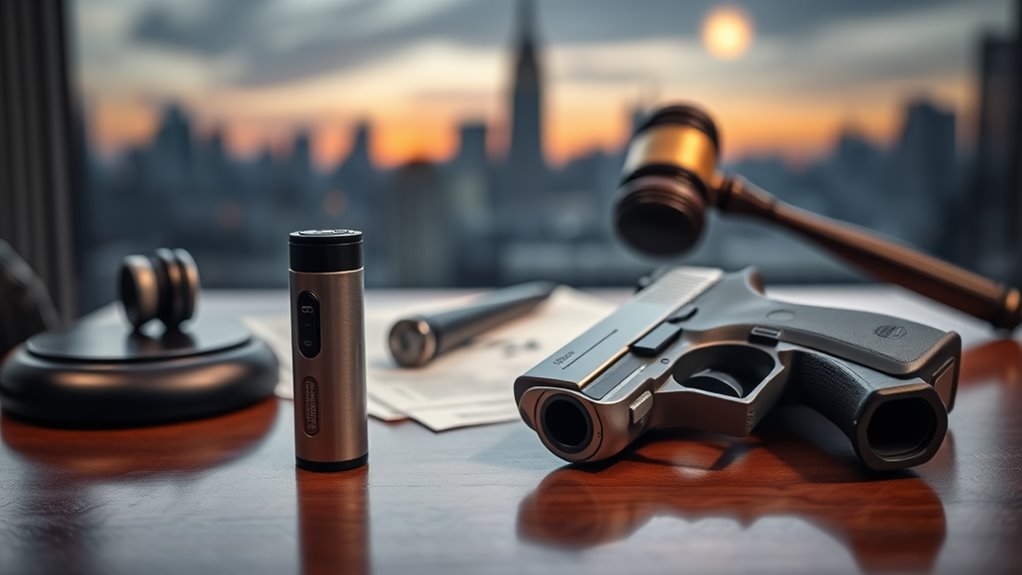
Maneuvering the legal landscape surrounding self-defense weapons is essential for anyone considering their options. You need to be aware of your legal rights and how state regulations vary. Not all weapons are treated equally, and the laws can change depending on where you live.
Here are some key points to keep in mind:
- Always check local laws before purchasing a stun gun or firearm.
- Understand the legal implications of using self-defense weapons.
- Know the age restrictions for ownership and usage.
- Familiarize yourself with the process for carrying weapons in public.
- Consider liability issues if you use a weapon in self-defense.
Staying informed will help you make a confident choice that aligns with the law and your safety needs!
Ease of Use
Understanding the legal considerations of self-defense weapons sets the stage for evaluating their practical use in real-life situations.
When it comes to user friendliness, stun guns often take the lead. They usually require just a simple press of a button to activate, making them easy to use, even for those who aren’t experienced with weapons.
Firearms, on the other hand, can be a bit more complicated. You need to know how to load, aim, and fire, which adds extra steps.
If you’re looking for operational simplicity, stun guns might just be your best bet. They’re lightweight and don’t need much training, letting you focus on staying safe rather than fumbling with complicated mechanics.
Keep it simple, right?
Effectiveness in Defense
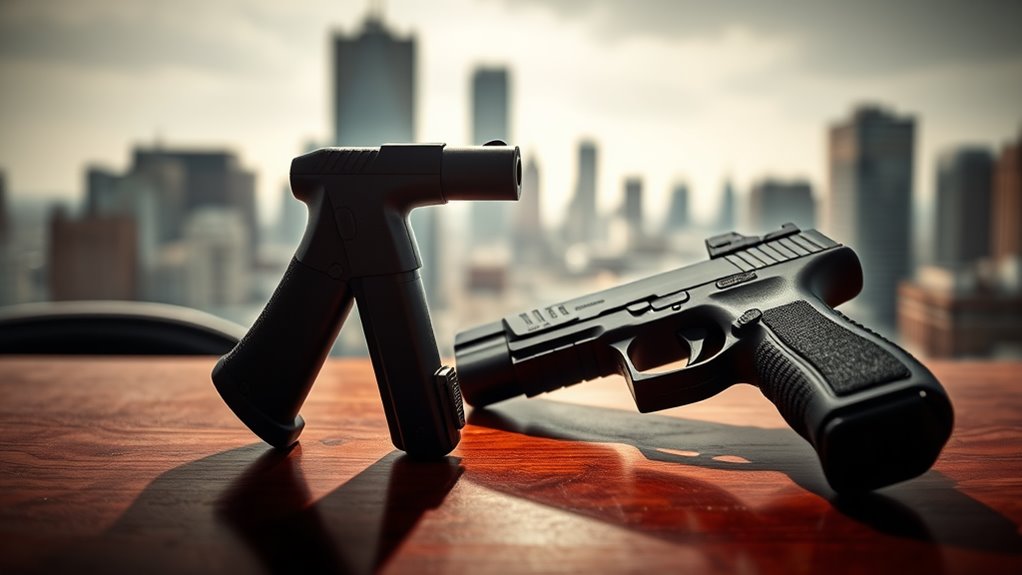
Effectiveness in self-defense can vary greatly between stun guns and firearms, with each option offering distinct advantages.
When considering which to use in self-defense scenarios, it’s crucial to compare their effectiveness.
- Stun guns can temporarily incapacitate an attacker.
- They’re less likely to cause permanent harm.
- Firearms can stop a threat quickly.
- They’re often more intimidating, potentially deterring attackers.
- Both options require practice to use effectively.
In an effectiveness comparison, think about your comfort level and the situations you might face.
Stun guns might be better for close encounters, while firearms can provide more distance.
Ultimately, knowing how each tool works in real situations can make all the difference when you need it most!
Risks and Limitations
When choosing between stun guns and firearms for self-defense, it’s vital to recognize their risks and limitations.
Stun guns can cause potential injuries, especially if used improperly or against someone with certain medical conditions. Plus, you’ve got to take into account the battery life; if it runs out, you’re left defenseless.
On the other hand, firearms come with their own set of dangers, including the risk of accidental discharge or harming innocent bystanders. They also require proper storage to prevent unauthorized use.
Weighing these factors is essential before making your choice. Remember, being prepared is important, but understanding the risks helps you stay safe and confident in any situation.
Choose wisely, and stay safe out there!
Training and Expertise
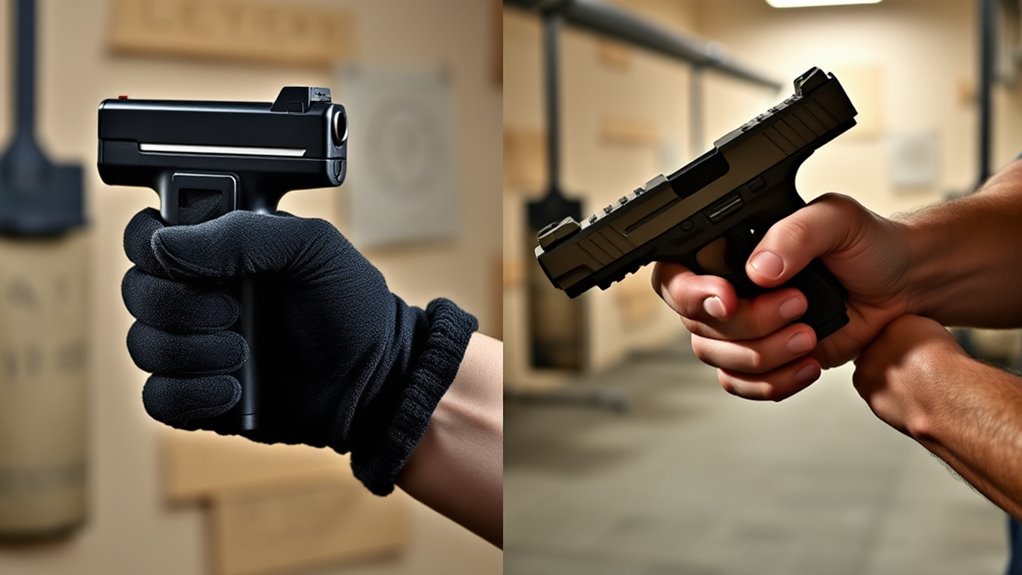
Having considered the risks and limitations of both stun guns and firearms, it’s clear that training and expertise play an essential role in your ability to defend yourself effectively.
You wouldn’t want to be caught in a tough spot, unprepared! So, exploring self-defense classes and training resources is a must.
Here’s what you should focus on:
- Choose the right class: Look for one that fits your needs.
- Practice regularly: The more you practice, the better you get.
- Learn the law: Know when you can use force legally.
- Stay calm under pressure: Practice stress management techniques.
- Get feedback: Ask instructors for tips to improve.
With the right training, you’ll feel more confident and ready to protect yourself!
Cost Comparison
Understanding the costs involved in choosing between stun guns and firearms for self-defense can help you make an informed decision.
Stun guns typically have a lower initial investment, often costing between $30 and $100. Firearms, on the other hand, usually start around $300 and can go much higher, depending on the model.
While stun guns are cheaper upfront, consider the long term expenses. Firearms might require more money for ammunition and maintenance, plus training costs.
Stun guns usually need less upkeep, but you might need to replace them if they’re used frequently.
Ultimately, weigh the initial investment against potential long-term expenses to find what fits your budget and needs.
After all, self-defense shouldn’t break the bank!
Personal Preference Factors
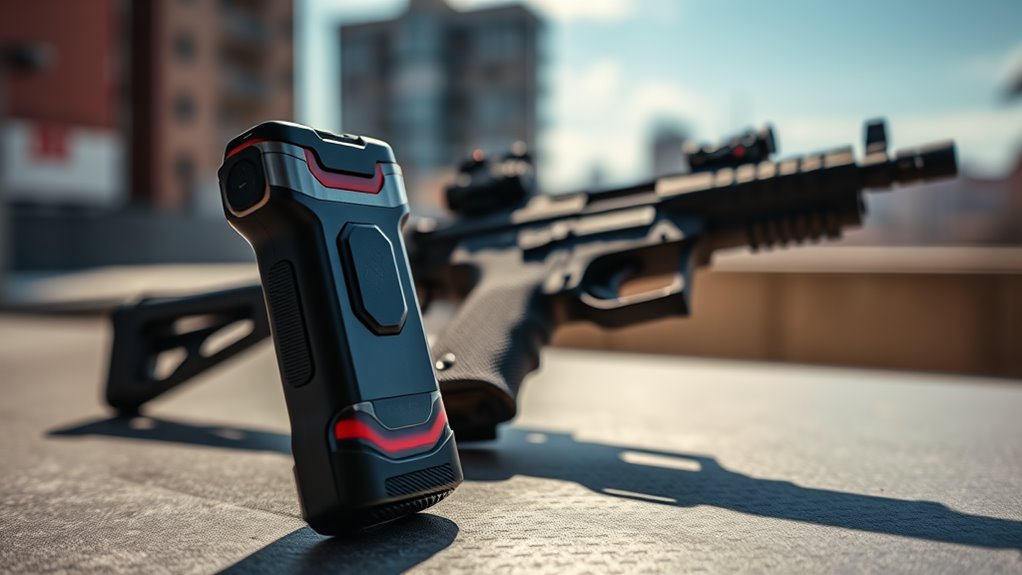
Considering your comfort level with different self-defense tools plays a significant role in choosing between stun guns and firearms. Your personal comfort and lifestyle choices shape how you’ll feel in a tense situation.
Think about these factors:
- Ease of Use: How quickly can you handle each tool?
- Weight and Size: Will you carry it easily?
- Legal Restrictions: Are there laws affecting your choice?
- Training Requirements: Do you want to practice more?
- Situational Awareness: How will you react under pressure?
Ultimately, whether you prefer a stun gun or a firearm should align with what feels right for you. Trust your instincts, and choose the option that makes you feel most empowered and safe.
Frequently Asked Questions
Can Stun Guns Be Used on Animals for Protection?
Stun guns can deter aggressive animals in self-defense situations, but you should always prioritize stun gun safety. Ascertain you’re familiar with local laws and use them responsibly to avoid unintended harm to the animal.
What Is the Average Range of a Stun Gun?
Like a lightning bolt in your hand, a stun gun typically has an effective range of 15 to 30 feet. Remember, stun gun effectiveness relies on safety; proper use guarantees you stay secure while deterring threats.
Are Stun Guns Effective Against Multiple Attackers?
Stun guns can be less effective against multiple assailants in self-defense scenarios since they typically incapacitate one person at a time. You’ll want to weigh your options carefully when facing multiple attackers.
How Often Should Stun Guns Be Recharged or Replaced?
You should recharge your stun gun regularly, ideally after each use. If you use it frequently, check the battery every month. Proper battery maintenance extends its lifespan, ensuring it’s ready when you need it most.
Can Stun Guns Be Legally Carried in All States?
Imagine a traveler maneuvering through a maze; each twist reveals different paths. Similarly, state regulations vary widely on stun guns. Some places allow them freely, while others impose legal restrictions. Always check local laws before carrying one.




